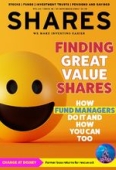Archived article
Please note that tax, investment, pension and ISA rules can change and the information and any views contained in this article may now be inaccurate.
Fund manager optimism starts to return as equity inflows hit 35-week high

Based on conversations with fund managers at AJ Bell’s annual Investival conference for financial advisers, there is a feeling that professional investors are starting to become more optimistic after what’s been a very tricky year on the markets.
This tallies with how stock markets in many parts of the world have recently started to pick up. Bank of America even says the middle of November saw the biggest inflows for equities in 35 weeks.
A key reason why some fund managers are more upbeat than you might expect is valuations. This year’s market sell-off has presented them with the opportunity to buy nearly everything on the market (apart from energy and tobacco stocks) at much cheaper levels than 2021.
While the headlines are full of doom and gloom, you just need to look at the news flow from listed companies to realise things aren’t as bad as you might think. Plenty of companies are hitting earnings forecasts which shows they are holding up well in the face of recession.
It’s important to remember that stock markets are forward-looking, and they’ve already priced in lots of bad news around a slowdown in the economy. Stocks have plummeted in general this year, yet earnings have held up relatively well. That has created a disconnect between company fundamentals (earnings) and share valuations.
In a nutshell, fund managers now have one of the best buying opportunities in years. Some have been buying more of what’s already in their portfolio and others have been taking new positions.
WHAT ARE THE CATALYSTS FOR A MARKET REBOUND?
Retail investors are eager to know if the current rebound in the markets is sustainable or just a short-term event. This is difficult to answer because there are still so many headwinds – inflation might be easing in places but remains high, consumer and business spending remains under pressure, and interest rates are still going up. The trick is to understand the key bits of information that would get a thumbs up from the market.
Kirsty Desson, manager of the Abrdn Global Smaller Companies Fund (B7KVX24), says some of the catalysts to drive markets higher will be inflation rolling over, labour markets softening and a pivot from the Federal Reserve with regards to the fierce pace and scale of interest rate hikes in the US.
While some of these catalysts might not emerge until later in 2023, the fact the latest US inflation figures weren’t as bad as feared might be the trigger for other dominos to fall as we move into the new year.
WILL RATES FALL IF THERE IS A FED PIVOT?
Clive Beagles from the JO Hambro UK Equity Income Fund (B03KR61) says it is important to understand that a pivot doesn’t mean we’ll suddenly see interest rates fall. ‘It means the trajectory flattens. We might see a 50-basis point increase, and then a 25-basis point rise at the following interest rate decision.’
He doesn’t believe rates will be cut any time soon and therefore it’s time for value stocks to shine. ‘It’s not time to buy growth shares,’ he adds.
As a reminder, the term growth stock typically refers to a company which is expected to generate much greater earnings in the future than today. Rising interest rates have a negative impact when calculating the present value of those expected cash flows. That’s why investors have exited growth stocks in their droves this year, as central banks aggressively push up rates.
They’re now looking at value stocks which offer good cash flow and profits today and trade on cheaper valuations.
HOW GROWTH STOCKS HAVE DERATED
Polar Capital Technology Trust (PCT) is a good example of an investment trust that has suffered from having large exposure to growth stocks in 2022. Its share price is down 30% year-to-date as many of its holdings have derated – trading on lower multiples of earnings, something that’s also called ‘multiple compression’.
However, manager Ben Rogoff is remarkably upbeat, saying the potential rewards from investing in the sector look more interesting than 18 months ago as valuations are no longer excessive.
‘Despite near-term macro and market turbulence, we believe the worst of multiple compression is likely behind us and secular tailwinds remain robust,’ he says.
‘A lot of the excess has been worked off. Within the areas we like, a year ago there were 25 software companies trading on more than 20 times forward sales. Today there are none.’
Rogoff says if you looked at the fastest growing cohort of software companies at that time, on average the ones growing at more than 40% were trading at 40 times enterprise value to sales. The companies that comprise that group today now trade at 11-times. ‘There has been a very significant unwind,’ he comments.
‘The valuations now look much better and there is definite upside risk. We could be at peak inflation and peak Fed, we could see China reopen, who knows what will happen in Ukraine and maybe there are positives there; but there is no way that fund managers are positioned for that.’
Rogoff says cash levels among fund managers haven’t been this high since 9/11, implying that on broad scale there is still a sense of nervousness among professional investors.
‘The downside risks remain significant too,’ he admits. ‘We must anticipate higher volatility and people need to be sure about the investment timeframe they are looking at. But we still remain optimistic.’
DISCLAIMER: Financial services company AJ Bell referenced in this article owns Shares magazine. The author (Daniel Coatsworth) and editor (Tom Sieber) of this article own shares in AJ Bell. The author has a personal investment in Abrdn Global Smaller Companies Fund
Important information:
These articles are provided by Shares magazine which is published by AJ Bell Media, a part of AJ Bell. Shares is not written by AJ Bell.
Shares is provided for your general information and use and is not a personal recommendation to invest. It is not intended to be relied upon by you in making or not making any investment decisions. The investments referred to in these articles will not be suitable for all investors. If in doubt please seek appropriate independent financial advice.
Investors acting on the information in these articles do so at their own risk and AJ Bell Media and its staff do not accept liability for losses suffered by investors as a result of their investment decisions.
Issue contents
Feature
- Fund manager optimism starts to return as equity inflows hit 35-week high
- Finding great value shares: how fund managers do it and how you can too
- Watch out for changes to dividend and capital gain allowances
- Is the hardy US shopper starting to feel the pinch?
- How I invest: the big lessons learned from a stock-picking journey
- Emerging markets: Views from the experts
- Find out about the top performing Indonesian market
Great Ideas
News
- Are dividends in the UK banking sector safe during a recession?
- How Currys shares have charged higher ahead of key trading period
- Why Zoom woes continue as it lowers revenue guidance
- New surge in China Covid cases halts rally in Asia-related stocks and investment funds
- Signs of life appear in the UK IPO market: Grindr shares gain 330% on debut
- Hilton Food shares in freefall after second warning in two months
 magazine
magazine








